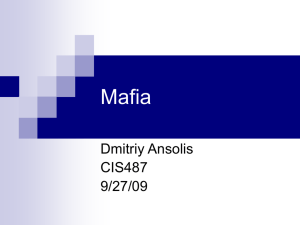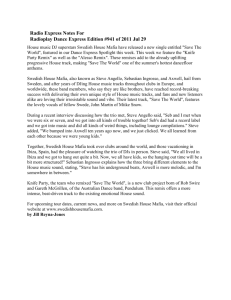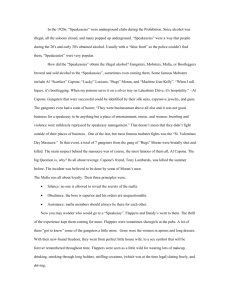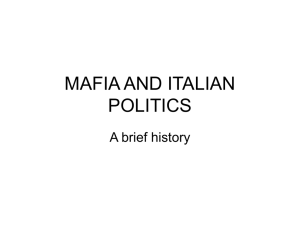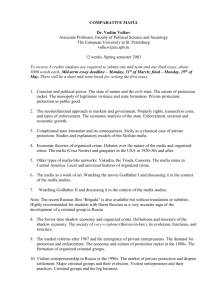Pulling the Strings- American Crime Film
advertisement
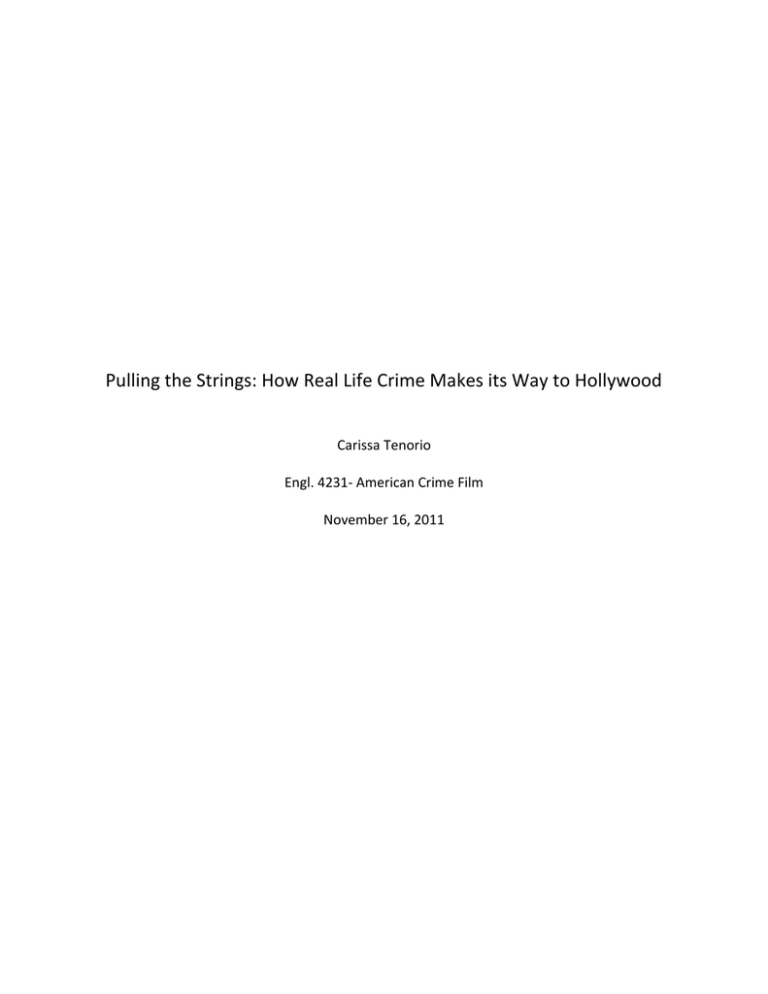
Pulling the Strings: How Real Life Crime Makes its Way to Hollywood Carissa Tenorio Engl. 4231- American Crime Film November 16, 2011 Tenorio Crime films have been around since the 1930s, but it was not until the early 1940s that we began to see hard-boiled detective films, instead of the typical murder mystery. Here is an example from the first movie we ever watched in class, the Maltese Falcon, which was part of the new film noir genre. During this class, we looked at themes, character developments and the femme fatal of each film. The element I wish our class had expanded upon more was the history behind cinema and films. Crime has been around since the beginning of mankind. However, the films I will be discussing, in depth, feature organized crime, which has been around since the beginning of Government. Crime film is directly affected by current crime in the media. Organized mafia crime took a strong presence in the media in the 1950s through the early 1960s. In the late 1960s, the Maxi trials began and were the first of a series of trials involving many major mafia “big heads.” “Sicilian prosecutors tried hundreds of Mafia suspects en masse for crimes ranging from murder to criminal association,” (Palermo, 2002). Simultaneously with the trials, Mario Puzo wrote his novel, The Godfather, which was released in 1969. Shortly after the novel in March of 1971, Mario Puzo and Francis Ford Coppola began filming “The Godfather”. At the same time “The Godfather” was filming, the Trial of 114 began in December of 1967 and lasted until December 1968. “This trial involved 114 men who were accused of crimes relating to the First Mafia War, the charges including multiple murders, kidnapping, tobacco smuggling, theft, "public massacre" (the Ciaculli bombing) and Organized Delinquency,” (Wikipedia.com, 2011).The Ciaculli bombing or massacre happened on June 30, 1963. This was caused by a bomb that exploded in a car in a town outside of Palermo, Italy. The bomb killed seven police officers. It was intended for Salvatore Greco head of the Mafia Commission and the boss of the Ciaculli Mafia family. Pietro Torretta was the man behind the bomb. Pulling the Strings 2 Tenorio “Although the exact origin of the word ‘mafia’ is uncertain, some believe it originated in 1282 during the French Invasion of Sicily and the saying, ‘Morte Alla Francia Italia Anela’ (Death to the French is Italy’s Cry), or MAFIA. Then eventually the word ‘mafia’ came to mean manly, in Sicily,” (Groove Club, 2000). The history of Italy is relevant to the Mafia since this is where it originated. I also think the fact that Mafia means manly is kind of interesting, since the men of Italian families are looked so highly upon. The First Mafia War took place in the 1960s between a few of the Mafia clans. A heroin shipment went missing that was being sent to American in December 1962. “Sicilian Mafia Commission couldn’t determine who was behind it. The La Barbera clan took this matter into its own hands and killed Calcedonio Di Pisa, one of the Mafioso of the Greco clan. They suspected that he was behind the missing shipment of heroin. This triggered a war between the Mafia clans and many people were killed in it.” (The Old Mafia, 2010). Puzo’s apparent interest in Mafioso’s and their lives was intriguing and interesting to watch as his book was translated to the big screen. The history behind the real mobsters is what makes half of the movie. I think people are often scared of scary movies, or disturbed by suspense, but there is nothing like a mobster movie that was based on real events. The violence of the families is unreal. Although not every single part of The Godfather comes from an event, the people in the book and films were based off of real mobsters. “The protagonist - Don Vito A. Corleone is based on real mob boss Frank Costello (Luciano/Genovese crime family). Don Corleone was born in the same year as Costello. Like Costello, he earned vast illegal incomes from gambling and bootlegging, while enjoying unrivalled political clout Pulling the Strings 3 Tenorio through his friends in the power. Costello was also a link between his criminal partners and politicians,” (factbehindfiction.com). Some other similarities the two shared included gambling interests in Las Vegas and Cuba. Neither Corleone nor Costello like narcotics. They had an assassination attempt on their lives and fortunately, for them at least, both survived. Puzo’s rendition of Costello (Don Vito Corleone) did have some differences. Corleone was made to be more old-fashioned than Costello. Also, Costello actually served time in jail, on several occasions and was overthrown from his position of power. “The shooting of Don Corleone while he stands at a fruit stand is similar to the murder of Frank Scalise in 1957. The Godfather’s political power referred to so often in the book, mirrors the political control wielded by New York mobsters Thomas Lucchese and Frank Costello throughout the 1940s and 1950s,” (Zapata-Kraj, 2009). According to Puzo, he became interested in the crime genre, because of his childhood dreams of being a Mafioso. As a child, Puzo admired and looked up to characters like Don Corleone. Puzo came from an Italian Immigrant family, who lived in Manhattan. He joined the American Army in World War II, but he was rejected because of his poor eyesight, (famouspeople.com, 2008). Growing up in an Italian family and having a fascination with Mobsters could have heavily influenced Puzo during the time he spent writing his best-selling novel. Maybe a biased was unintentionally formed. The real, historic stories about American mobs were available for Puzo to research and transform into his stories. Although his previous books were not best-sellers, people liked the books about the Mafia, and the books received good responses from the public. Pulling the Strings 4 Tenorio “The Mafia is oppression, arrogance, greed, self-enrichment, power and hegemony above and against all others. It is not an abstract concept, or a state of mind, or a literary term… It is a criminal organization regulated by unwritten but iron and inexorable rules… The myth of a courageous and generous ‘man of honor’ must be destroyed, because a Mafioso is just the opposite.” (Terranova, 1979) Most people are heavily opinionated and perceive mafia organizations their crimes negatively, but Puzo, used the mafia and the mafia’s image of that time period and turned it into a world most people had never witnessed and would never. His book allowed your average Joe to understand Mafia life. The film, “The Godfather” leased in 1972, was just a visual of the violence, but this book and film intrigued a lot of people. The film was created not for the mafia, not for the public officials, not for the cops, but for the public who doesn’t understand mafia life. Frank Lucas was a heroin dealer and organized crime boss operating in Harlem during the late 1960s and early 1970s. He was best known for getting heroin himself from the direct source in the Golden Triangle, and smuggling it into America on dead servicemen’s coffins, or at least that is what he says. In 2007, he was played in American Gangster, by Denzel Washington. Heroin has been in the United States since the late 1800s and was used for various medications. Frank Lucas is an important figure because during his reign, Heroin started to become huge in the United States. This was happening at the same time the First Mafia War had begun, over missing heroin. “During the 1960s, the Sicilian "Cupola" and the American "Commission" began to seriously cooperate in the narcotics trade, despite their expressed sentiment that heroin and cocaine were somehow less "respectable" products than extortion and murder,” (Best of Sicily, 2004). This was the Pulling the Strings 5 Tenorio prime time for the mafia to get into drugs, but many mafia organizations did not know it would eventually start a war between the different mobster families. There is no doubt in my mind, that crime is a fascination to people. Television shows, newspapers, books, and other forms of entertainment continue to dish out things about organized crime and mobster lifestyles. Organized crime also gets much attention due to politicians. “While many of Puzo’s details about organized crime are probably based on information readily available from research, there are specific incidents in the book that resemble events in crime history,” (Zapata-Kraj, 2009). The Godfather, a best-sellers novel had a huge impact on the pop culture of that time. Since the media loves writing about it, the public was interested in it. Today we see the same aspect, just in a more fictional way. Stephanie Meyer and J.K. Rowling did a very similar thing. They wrote best-selling novels, and films followed their movies. Harry Potter and the Sorcerer’s Stone (novel) was released in America on September 1, 1998. The movie shortly followed, being released on November 16, 2001. This wizard phenomenon was followed by television shows being released and a huge trend on witch craft. Same thing goes for Stephanie Meyer’s novel Twilight, which was released in 2005 and the film was shortly after in 2008. Her books caused a huge wave of vampire obsession. Television shows, novels, and movies followed the same ideas. Although these examples are not directly correlated with crime film, they still follow the trend of having an explosion of popularity, due to current media. The Godfather, the films and novel, did more to change public beliefs about the mafia than any other combination of exposes in the past. “Before the advent of The Godfather, federal courts were very strict about excluding referenced to the mafia per se, and any prosecutor who was carless in that regard was certain to have a nasty mistrial on his or her Pulling the Strings 6 Tenorio record. Moreover, when jurors were questioned at all about whether they believed in such a thing as organized crime, most were uncertain and the rest were doubters… After The Godfather became so popular, it was the defense attorneys who wanted to ask the questions and assess the extent of the damage- and the extent was really quite substantial. Jurors believe that the Mafia existed, and they had a fixed understanding from Hollywood about exactly how the Mafia operated. That change in public perceptions was important for the courtroom battles which were about to the launched in the latter 1970s,” (Federal Prosecutor, 2009). This film is a prime example of taking an issue or topic of public interest and transforming it into an obsession among readers and viewers. The Mafia and organized crime have always been a topic people enjoy learning about because a great majority of this nation has never been involved in it. Another example of “organized crime” that has been all over the media since the mid-1960s is the C.I.A. Not a typical “organized crime,” society but none the less, still have the typical organized crime feel. The Good Shepherd is a spy film directed by Robert De Niro. Although, a fictional film based on real events, it is supposed to be the start of counter-intelligence in the Central Intelligence Agency. The film's main character, Edward Wilson is loosely based on James Jesus Angleton and Richard M. Bissell. This movie is set back in the 1960s when the Bay of Pigs was happening in Cuba. Fun fact, Bahía de Cochinos, is the actual translation that means Bay of Fish, not Pigs. This film gets its historical value from the C.I.A. during the 1960s. However the Good Shepherd was first written during the early 1990s, when the CIA was involved in The Cold War that ended in late 1991. The Soviet Union collapsed in 1991, Pulling the Strings 7 Tenorio ending the Cold War. This left the United States as the dominant military power. The Cold War is always referenced about spies in pop culture today, and had a significant impact on the world. “James Jesus Angleton was born in 1917, in Boise, Idaho. Upon Graduation from Yale in 1941, Angleton moved to Harvard Law School. Inducted into the Army on 19 March, 1943, Angleton was recruited into the OSS in August through the efforts of Angleton's father and Norman Pearson, his old English professor from Yale who was, at that time, head of the OSS Counter Intelligence division in London,” (Cooper, 2000). “Richard Bissell was born in 1910. Bissell worked for the Ford Foundation for a while but Frank Wisner, persuaded him to join the Central Intelligence Agency. Its role was to evaluate intelligence reports and coordinate the intelligence activities of the various government departments in the interest of national security,” (Spartacus Educational, 2011). Both Bissell and Angleton attended Yale University and were members of the secret society, known as Skulls and Bones. “Skull and Bones is the oldest of Yale’s secret societies and by far the most determinedly secretive. As such, it has long been an inspiration for speculation and imagination,” (Robbins, 2000). It has also been said that Yale University, specifically in their English department, and Skull and Bones were major recruiting groups for the C.I.A. Angleton and Bissell were both major players in the beginning of the C.I.A. However, there were a couple of differences in this film, from actual accuracy. The character of Edward Wilson, played by Matt Damon, was based off of Angleton, who attended Yale University, but he was Hispanic. Angleton was also not involved with The Bay of Pigs invasion. In the film, we see that The Pulling the Strings 8 Tenorio Bay of Pigs failed because of a Cuban spy leaking information, when in reality the invasion failed because people were ill-prepared. Richard Bissell was the actual C.I.A. officer in charge of The Bay of Pigs. “As Bissell tells it, it was Eisenhower who relentlessly pushed the operation forward, refusing to acknowledge that no force less powerful, and less covert, than the 82nd Airborne was going to take out Castro. Kennedy compounded matters by constantly reducing U.S. support for the invasion, earning himself the contempt of the entire U.S. military, who despised him for sending men into combat and not backing them up,” (Vanneman, 2007). This film, when the screenplay was originally being written, has incredible history behind the characters and plot, itself. The Film was influenced by The Bay of Pigs and the creation of the C.I.A. “The Bay of Pigs invasion met its ignominious end on the afternoon of 19 April 1961. Three days after the force of Cuban émigrés had hit the beach, the CIA officers who planned the assault gathered around a radio in their Washington war room while the Cuban Brigade's commander transmitted his last signal,” (Warner, 2007). Crime in this film is very different from crime in the mafia, on really only one count. The C.I.A. is so secretive the current media, when this film was written, wasn’t able to capture the details of any of the C.I.A.s involvement of much. They only knew brief details. “It was started by Coppola and Eric Roth (screenwriter). Then it went through with other directors. There were certain parallels. That was about a secret society and this is about another type of secret society, but very Americana. One of the best lines in the movie to me is in the Joe Pesci scene where he says, “What do you people have?” and Matt Damon says, “The United States of America- the rest of you are just visiting,” (Franklin, 2006). Pulling the Strings 9 Tenorio In 1994, which was when “The Good Shepherd” was written there wasn’t much to talk about as far as the C.I.A. goes, but screenwriter Eric Roth, has been very interested in the subject matter. Almost 12 years ago, "The Good Shepherd" began its journey to the big screen when Eric Roth tucked the Oscar statuette he'd just earned for writing "Forrest Gump" into a corner of the den of his beach house and began drilling into a subject that had captivated him for decades: the CIA,”(Hart, 2006). Years after the Bay of Pigs and the end of The Cold War, documents on the events were released to the public that gave information about the C.I.A. spying on Americans during the 1960s. “Known inside the agency as the “family jewels,” the 702 pages of documents catalog domestic wiretapping operations, failed assassination plots, mind-control experiments and spying on journalists from the early years of the C.I.A. The papers provide evidence of paranoia and occasional incompetence as the agency began a string of illegal spying operations in the 1960s and 1970s, often to hunt links between Communist governments and the domestic protests that roiled the nation in that period,”(Chicago Times, Horn, 2007). “Pegging his narrative to the CIA's early days leading up to 1961's Bay of Pigs invasion, Roth found the point of entry to his Cold War saga after he read Norman Mailer's CIA-themed novel "Harlot's Ghost" and perused the biography "Cold Warrior: James Jesus Angleton, the CIA's Master Spy Hunter." Using Angleton as his "primogenitor," Roth created tight-lipped WASP counterintelligence boss Edward Wilson, portrayed in the film by Matt Damon. The character also incorporated details modeled after Frank Wisner, who orchestrated a coup in Iran, and Bay of Pigs covert operative Richard Bissell,” (Hart, 2006). Pulling the Strings 10 Tenorio Something I found interesting during my research was that there was a C.I.A. agent during the 1950s and 1960s named Edwin Wilson. He doesn’t really have much to do with Edward Wilson, but Edwin’s story is still interesting. He was in jail for 22 years after he was charged for selling weapons to Libya. He was released from prison in 2004. Although his timeline doesn’t match up with the writing of this film, it was more bad press for the C.I.A. Roth said a topic of interest for him was the family life of a C.I.A. agent and the emotional strain it has on this aspect of their lives. His interest in Francis Ford Coppola shouldn’t come as much of a surprise. Coppola, who directed “The Godfather’s”, had also expressed great interest in the C.I.A. “I asked if I could go and see him; we'd met a couple of times. I told him the idea I had and he liked it very much,” (Roth, 2007). The C.I.A. is commonly a topic people don’t know a lot about. It’s a very secret “underground” society, if you will, much like the Mafia as said before. Although, as discussed in class, the government is on the side of the C.I.A. since it was created by them, that doesn’t seem fair. They get away with more than your average mobster, because they are one with the law. In the last film I will look at, is a classic example of this. The difference in this film is that our main character decides to turn to the government for help. This gangster classis, “Goodfellas,” has great historical content behind it. The film based off of the non-fictional book Wiseguy: Life in a Mafia Family was about a low-level, gangster, named Henry Hill, who is Irish. He told the FBI about the mobsters/gangsters in the area including his longtime friend, and was entered into the Witness Protection Program to save his life. Pulling the Strings 11 Tenorio Similar to The Godfather, Wiseguy: Life in a Mafia Family is surrounded by factual events of the Mafia. As briefly noted previous, Thomas Lucchese, was a power house in the New York Mafia. Lucchese was the family boss from 1951- 1967 and became one of the most-respected Mafia bosses of the era. (organizedcrimeencyclopedia.wikia.com). The Lucchese family is one of the five most powerful Mafia families in New York and can be traced all the way Corleone, Sicily. Henry Hill, who began his Mafia life in 1955 was also part of the Lucchese Mafia family. Nicholas Pileggi, author of Wiseguy had a fascination with Mafiosi in New York and wanted to write about them. He became a writer in New York in 1956 during the rise of Mafia life which most likely influenced his writing later in life. Wiseguy was published in 1985, which happened to be during the Mafia Commission Trial. The Mafia Commission Trial was from February 1985- November 1986, in New York City. Eleven famous Mafia people, including individuals from the five Mafia Families were tried. “The Commission Trial was probably the greatest attack on the structure of Mafia, as stated by the Time Magazine who referred to this trial as the Case of Cases,” (theoldmafia.com, 2010). This film, which was released in September 1990 shortly followed by The Godfather III in December, 1990, is an example again that during the time that the author was writing this book, many events in both Pileggi’s lifetime and during the actual writing of the book, could have easily, directly affected him in writing the non-fictional novel. While Pileggi was a writer in New York, for the Associated Press form 1956- 1968, the Mafia seemed to have cooled down from the media. Although there was always something happening in the Mafia, nothing big arose until the 1970s when The Great Mafia War began, also known as the Second Mafia war. Pulling the Strings 12 Tenorio The Great Mafia War was not specific about people involved. This war involved the whole Mafia, which changed most of the dynamics of the organization. The Second Mafia War had more violence then the First Mafia War and had over 1000 homicides. From 1981-1983 most of the killings occurred, however the first shots fired were in 1987. (secondmafiawar.com) Similar to the first war, “The victors dragged the killing out until the end of the 1980s as they disposed of their allies. In addition to the violence within the Mafia itself, there was violence against the state, including a campaign of deliberate assassinations of authority figures, such as judges, prosecutors and politicians,” (xtimeline.com, 2009). “From 1981 through last year, federal prosecutors brought 1,025 indictments against 2,554 Mafiosi, and have convicted 809 Mafia members or their uninitiated "associates.",” (Magnuson, 2001). As stated in this paper numerous times, the Mafia world was crazy from the 1950s- through the 1980s. Henry Hill, the main character of Wiseguy: Life in a Mafia Family had a Mafia life for over 30 years. This was almost exactly the same years that Pileggi was working as a writer in New York City. I’d also like to argue that because Pileggi was in a position to report stories, he was able to hype public interest in the Mafia. Although during his writing career at Associated Press, he may not have done so, he was certainly saving his interest in the Mafia for something, looks like it was his books. He was also the author of Casino. Something Wiseguy did well was show the life of a mobster who actually wasn’t a true mobster. I say this because Hill wasn’t Italian, he was Irish and we follow his life into the Mafia. Obviously we see a similar story line in The Godfather trilogy, but it’s not a true, true story, just like in “The Good Shepherd.” Pulling the Strings 13 Tenorio “The Godfather”, “The Good Shepherd”, and “Goodfellas” were based loosely off of real historical events, which is one of the very reasons I find them to be so fascinating. “Goodfellas” may be the most accurate because it is based off a non-fictional book, the other two movies dissected in this paper, were made just as well. All three films had a direct correlation with the Mafia. Puzo, grew up in Mafia territory. James Jesus Angleton and Richard Bissell were both in the C.I.A., which is arguably very similar to the Mafia. Finally, Pileggi had a keen interest in the Mafia and Henry Hill, whom the book is about, was an active member in the Lucchese Mafia Family. The current media of each one of these films was influenced in one way or another which made them bigger hits then they probably should have been. The Godfather, published in 1969, and the film released in 1972- Mafia all over the headlines. “The Good Shepherd,” written in 1994, but based off of characters from the early 1960s. This again played a major role in the buzz of the film. Lastly, “Goodfellas” was based off the book which was written in 1985, but was based off of the life of Henry Hill starting in 1955. The three film examples are good enough proof for me that crime film is directly affected by the media and the crime of that time. The Godfather I, II, and III, may have been released at different times, but the background of those stories was written during a time when the world couldn’t get enough of the Mafia. As for “The Good Shepherd,” the writers and the basis of this story all came from the decades when the C.I.A. had a lot on their back and Roth had an interest in the background of the C.I.A. “Goodfellas,” was based off historical truth during the rise and fall of Mafia life. The Mafia and their families may still be an interest to the public now. Since my generation, seems to look at the Mafia as a topic from years ago, people may not be so eager to see Ben Afflict, Pulling the Strings 14 Tenorio living in Boston, acting like a gangster. We would rather watch older films that have a more accurate depiction of the Mafia. Relevant to this time now, we see the Mexican drug cartel all over our news. In the near future we will be seeing movies pop up about the drug war. Most people understand the idea of what is happening in Mexico right now, but the fact is that most of the world population won’t experience any of the violence. I’m not sure if the violent side of crime film is what makes it so intriguing but it seems to capture people’s eyes often. “Savages”, coming out in 2012, is a film that portrays a woman being taken for ransom in the Mexican drug cartel. Another film that is coming soon is “The Last Stand,” is to be released in 2013, which is about a drug cartel boss being stopped by a Sheriff in Texas. Crime film is such a bizarre genre of films and I find it to be sad that the big blockbuster films are heavily influenced by what our media says to be the most noticing. Crime film is directly influenced by the current crime in the media. Pulling the Strings 15 Tenorio American Movie Classics Company. (2011). Goodfellas- 1990. Retrieved from http://www.filmsite.org/goodf.html Coffey, Thomas G. & Dujmovic, Nicholas, & McCollim, Gary, & Robarge, David. (May 25, 2007). The Good Shepherd: Intelligence in Recent Public Media. Central Intelligence Agency. Retrieved from https://www.cia.gov/library/center-for-the-study-of-intelligence/csipublications/csi-studies/studies/vol51no1/the-good-shepherd.html Famento. (2008-2009). Second Mafia War alters Balance of Power Retrieved from http://www.xtimeline.com/evt/view.aspx?id=130313 Franklin, Garth. (December 21, 2006). Interview: Robert De Niro for “The Good Shepherd”. Dark Horizons. Retrieved from http://www.darkhorizons.com/features/1058/robertdeniro-for-the-good-shepherd Horn, John. (December 17, 2007). After a series of false starts, `Shepherd' finally gets made. Chicago Tribune. Retrieved from http://articles.chicagotribune.com/2006-1217/news/ 0612170300_1_james-angleton-fingers-john-frankenheimer Hugh Hart. (December 31, 2006). Secrets of the CIA. Retrieved from http://articles.sfgate.com/2006-12-31/entertainment/17326877_1_james-jesusangleton-cia-s-master-spy-hunter-counterintelligence John Simkin. Richard Bissell. (October 20, 2011). Spartacus Educational. Retrieved November 19, 2011, from http://www.spartacus.schoolnet.co.uk/JFKbissell.htm La Cosa Nostra Database. (2007-2011). The Lucchese Family. Retrieved from http://www.lacndb.com/php/Info.php?name=Family%20-%20Lucchese Pulling the Strings 16 Tenorio Magnuson, Ed. (June 24, 2001). Hitting the Mafia. Time U.S. Retrieved from http://www.time.com/time/nation/article/0,8599,145082,00.html#ixzz1eJIgJgKN Mazzetti ,Mark & Weiner, Tim. (June 27, 2007). Files on Illegal Spying Show C.I.A. Skeletons from Cold War. Retrieved from http://www.nytimes.com/2007/ 06/27/washington/ 27cia.html?pagewanted=all Murray, Rebecca. (2011). Actor/Director/Producer Robert De Niro Discusses "The Good Shepherd". About Guide. Retrieved from http://movies.about. com/od/ thegoodshepherd /a/shephrdrd121306.htm Robbins, Alexandra. (1998). Skull and Bones Society. Retrieved from http://www.skullandcrossbones.org/articles/skullandbones.htm Vanneman, Alan. (February 2007). Robert De Niro at Yale Again!. Retrieved from http://www.brightlightsfilm.com/55/goodshepherd.php Wikia.com. (December, 2009).Organized Crime Encyclopedia. Retrieved from http://organizedcrimeencyclopedia.wikia.com/wiki/Thomas_Lucchese Zapata-Kraj, Marta. (2009). Mafia- the History with M Puzo’s Godfather in background. Research Paper. Retrieved from http://books.google.com/ books?id= IXbTLH s7ASc C&pg =PA29& lpg=PA29&dq= crime+directly+impacting +Mario +Puzo's,+the+ god father&source=bl&ots=6nwsFYUEmH& sig=ipIkZ w5KA9Mh IsDp 0uFkYu tXL8&hl =en &ei=o2JTqz6L4u3twfNIHzCw&sa=X&oi=book_result&ct=result&resnum=7&ved=0CFY Q6AEwBg#v=onepage&q=crime%20directly%20impacting%20Mario%20Puzo's%2C% 20the%20godfather&f=false Pulling the Strings 17
